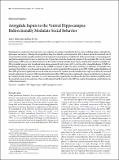| dc.contributor.author | Felix-Ortiz, Ada Celis | |
| dc.contributor.author | Tye, Kay | |
| dc.date.accessioned | 2014-11-04T15:57:40Z | |
| dc.date.available | 2014-11-04T15:57:40Z | |
| dc.date.issued | 2014-01 | |
| dc.date.submitted | 2013-11 | |
| dc.identifier.issn | 0270-6474 | |
| dc.identifier.issn | 1529-2401 | |
| dc.identifier.uri | http://hdl.handle.net/1721.1/91289 | |
| dc.description.abstract | Impairments in social interaction represent a core symptom of a number of psychiatric disease states, including autism, schizophrenia, depression, and anxiety. Although the amygdala has long been linked to social interaction, little is known about the functional role of connections between the amygdala and downstream regions in noncompetitive social behavior. In the present study, we used optogenetic and pharmacological tools in mice to study the role of projections from the basolateral complex of the amygdala (BLA) to the ventral hippocampus (vHPC) in two social interaction tests: the resident-juvenile-intruder home-cage test and the three chamber sociability test. BLA pyramidal neurons were transduced using adeno-associated viral vectors (AAV[subscript 5]) carrying either channelrhodopsin-2 (ChR2) or halorhodopsin (NpHR), under the control of the CaMKIIα promoter to allow for optical excitation or inhibition of amygdala axon terminals. Optical fibers were chronically implanted to selectively manipulate BLA terminals in the vHPC. NpHR-mediated inhibition of BLA-vHPC projections significantly increased social interaction in the resident-juvenile intruder home-cage test as shown by increased intruder exploration. In contrast, ChR2-mediated activation of BLA-vHPC projections significantly reduced social behaviors as shown in the resident-juvenile intruder procedure as seen by decreased time exploring the intruder and in the three chamber sociability test by decreased time spent in the social zone. These results indicate that BLA inputs to the vHPC are capable of modulating social behaviors in a bidirectional manner. | en_US |
| dc.description.sponsorship | Whitehall Foundation | en_US |
| dc.description.sponsorship | Esther A. & Joseph Klingenstein Fund, Inc. | en_US |
| dc.description.sponsorship | Picower Institute for Learning and Memory (Innovation Fund) | en_US |
| dc.description.sponsorship | Whitehead Institute for Biomedical Research (Career Development Professorship) | en_US |
| dc.description.sponsorship | National Institutes of Health (U.S.) (New Innovator Award 1DP2DK102256-01) | en_US |
| dc.language.iso | en_US | |
| dc.publisher | Society for Neuroscience | en_US |
| dc.relation.isversionof | http://dx.doi.org/10.1523/jneurosci.4257-13.2014 | en_US |
| dc.rights | Article is made available in accordance with the publisher's policy and may be subject to US copyright law. Please refer to the publisher's site for terms of use. | en_US |
| dc.source | Society for Neuroscience | en_US |
| dc.title | Amygdala Inputs to the Ventral Hippocampus Bidirectionally Modulate Social Behavior | en_US |
| dc.type | Article | en_US |
| dc.identifier.citation | Felix-Ortiz, A. C., and K. M. Tye. “Amygdala Inputs to the Ventral Hippocampus Bidirectionally Modulate Social Behavior.” Journal of Neuroscience 34, no. 2 (January 8, 2014): 586–595. | en_US |
| dc.contributor.department | Massachusetts Institute of Technology. Department of Brain and Cognitive Sciences | en_US |
| dc.contributor.department | Picower Institute for Learning and Memory | en_US |
| dc.contributor.mitauthor | Felix-Ortiz, Ada Celis | en_US |
| dc.contributor.mitauthor | Tye, Kay | en_US |
| dc.relation.journal | Journal of Neuroscience | en_US |
| dc.eprint.version | Final published version | en_US |
| dc.type.uri | http://purl.org/eprint/type/JournalArticle | en_US |
| eprint.status | http://purl.org/eprint/status/PeerReviewed | en_US |
| dspace.orderedauthors | Felix-Ortiz, Ada Celis; Tye, Kay | en_US |
| dc.identifier.orcid | https://orcid.org/0000-0003-0652-5652 | |
| mit.license | PUBLISHER_POLICY | en_US |
| mit.metadata.status | Complete | |
